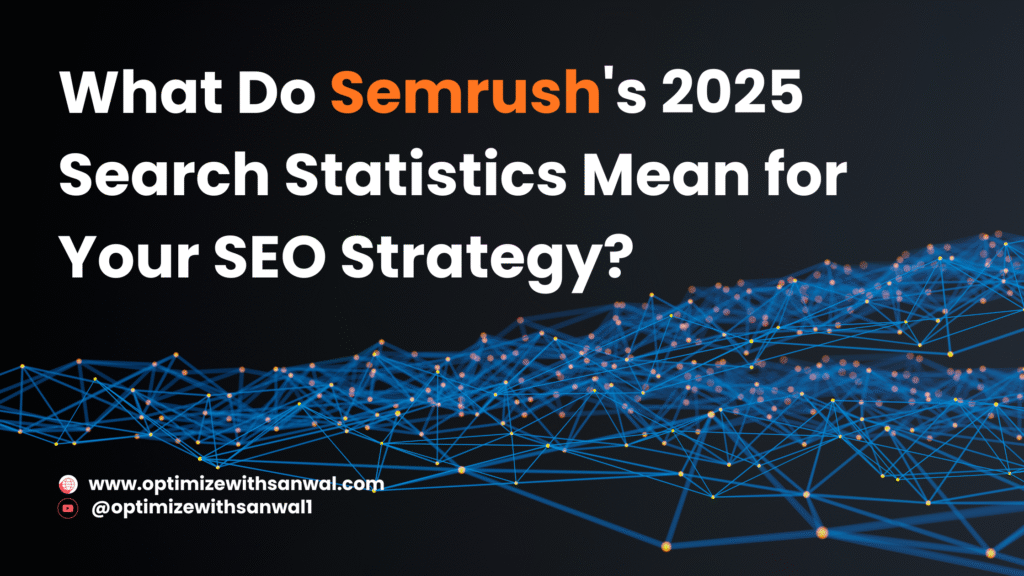Every year, the SEO community looks forward to new data that can give us an evidence-based look at the state of Google Search. I’ve just spent the day deeply analyzing the latest report from Semrush, “29 Eye-Opening Google Search Statistics for 2025,” and the findings are critical for any serious strategist. All data in this analysis comes from their excellent research.
In this guide, I’m not just going to list the stats; I’m going to give you my analysis on what these numbers actually mean for your strategy.
What is the State of Google’s Dominance and User Behavior?
The first takeaway from the Semrush data is that despite a rapidly changing landscape, Google’s scale remains almost unimaginable.
- Google processes an estimated 9.5 million searches every minute.
- It still holds a commanding 89.66% of the global search engine market.
- Ranking number one on mobile still carries a huge advantage, with an average click-through rate (CTR) of 22.4%.
Strategic Analysis: These numbers tell me one clear thing: Google Search is not going anywhere. While Google’s overall traffic may have dipped slightly post-ChatGPT, Semrush’s data confirms it’s still the undisputed king. A 22.4% CTR for the top spot means that winning the SERP is still one of the most valuable goals in marketing. Furthermore, with over 60% of U.S. searches happening on mobile and mobile-first indexing now complete, it’s clear that if you’re not winning on mobile, you’re not winning at all.
How is AI Fundamentally Reshaping the SERP?
The most significant trend in the Semrush report is the impact of AI. The data shows Google’s own AI is changing the search results page.
The study found that AI Overviews (AIOs) now appear for 13.14% of all Google searches as of March 2025, more than doubling from just 6.49% in January 2025.
Strategic Analysis: This is where it gets interesting. According to the data, AIOs link to an average of five sources, and of those, only 52% also appear in the top 10 organic results. This means 48% of the time, Google’s AI is citing a source that isn’t on page one. This, in my opinion, creates a massive “page two” opportunity for SEOs. It’s a new backdoor to visibility, where creating incredibly high-quality, citable content can get you featured in the AIO even if you don’t hold a top-10 ranking.
What Do We Now Know About Local and Shopping Search?
This is an area I previously overlooked, and the data from Semrush is too important to ignore.
- About 75% of consumers use Google when looking for local business information.
- Searches on Google Maps for “shopping near me” increased globally by over 100% in 2022.
- Google’s AI-powered Shopping Graph contains over 35 billion product listings.
- Online shoppers click on 3D images 50% more than static ones.
Strategic Analysis: This data is a clear signal that for e-commerce and local businesses, the game has changed. Your Google Business Profile is no longer optional; it’s a primary driver of customers. For product sellers, getting your products into Google’s Shopping Graph and utilizing features like 3D images is essential for visibility. Relying on traditional blue-link organic results for these queries is a losing strategy.
What Are the Key Strategic Takeaways for SEOs in 2025?
Synthesizing all the data from the Semrush report, here are what I see as the most critical strategic priorities for the coming year:
- The SERP is now a battle for the click. With 13.14% of queries showing AIOs, it’s not just about ranking. You must create content and titles that are more compelling than Google’s own AI answer.
- Mobile isn’t just ‘first,’ it’s everything. With over 60% of searches and a fully mobile-first index, all optimization efforts must be viewed through a mobile lens.
- Rich features are the new frontier. For local and e-commerce, optimizing for Google Business Profile, the Shopping Graph, and 3D images is no longer an advanced tactic; it’s essential for survival.
- There’s a new ‘page two’ opportunity. The fact that AIOs cite pages outside the top 10 is a new pathway to visibility. This makes creating deeply authoritative, citable content more important than ever.
My Final Thoughts
The latest data from Semrush paints a clear picture: the world of search is becoming more dominated by AI, more mobile-centric, and more competitive. As strategists, our job is to adapt by focusing on deep value, flawless mobile experiences, and understanding the new opportunities within the evolving SERP landscape.
About Me
I’m Sanwal Zia, a certified SEO strategist and the founder of Optimize with Sanwal. With expertise recognized by prestigious organizations, I focus on building effective search strategies that drive growth. You can connect with me on YouTube, my Website, LinkedIn, Facebook, and Instagram.


